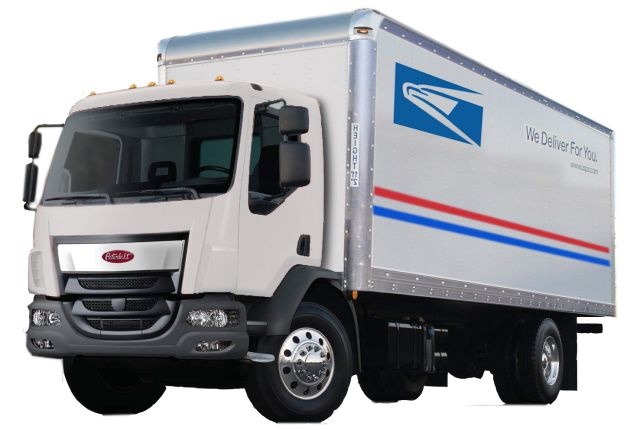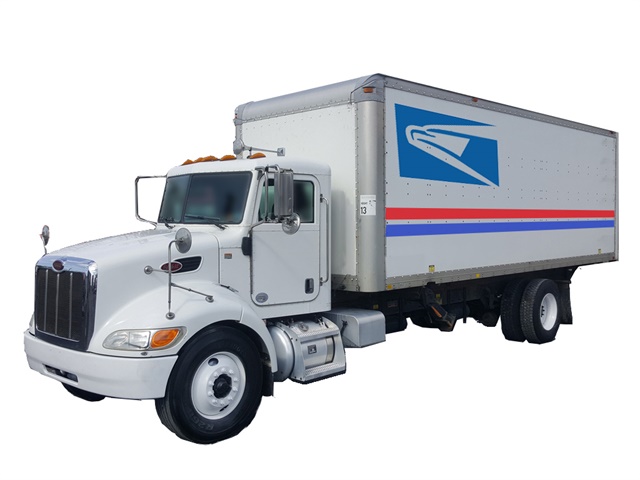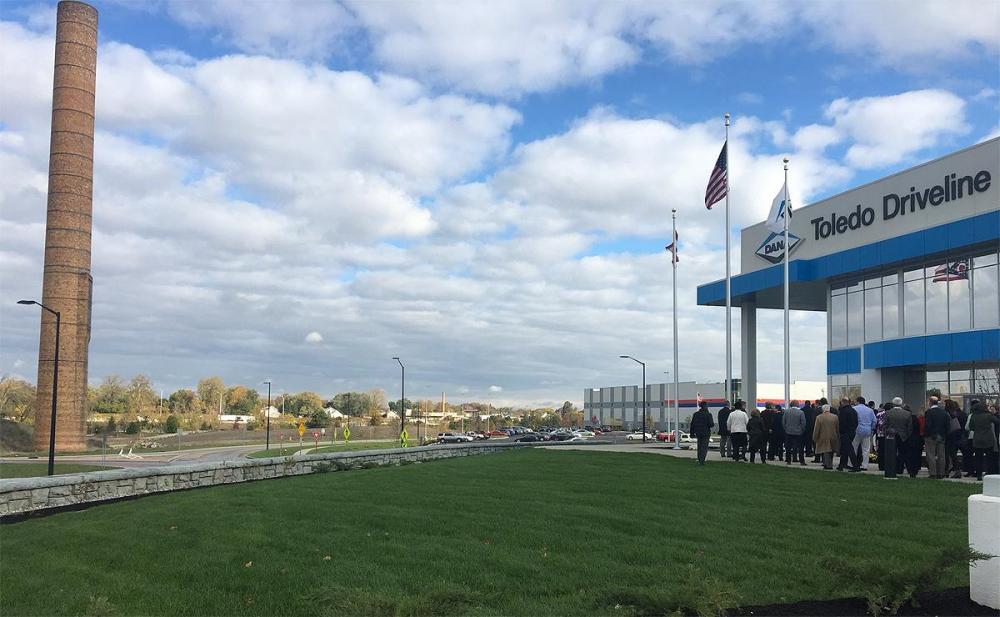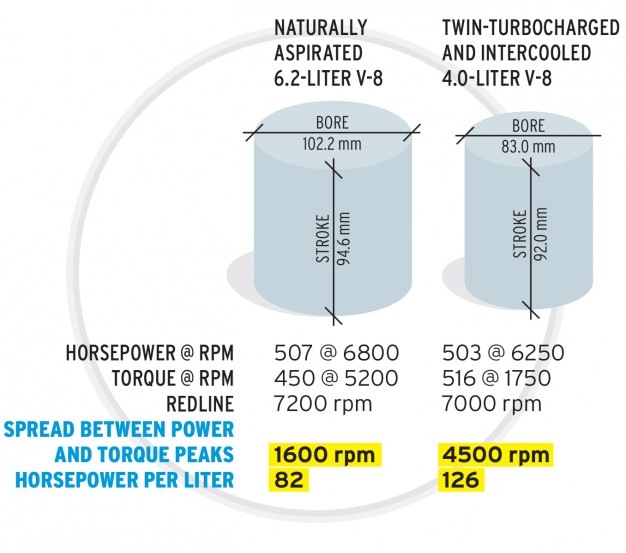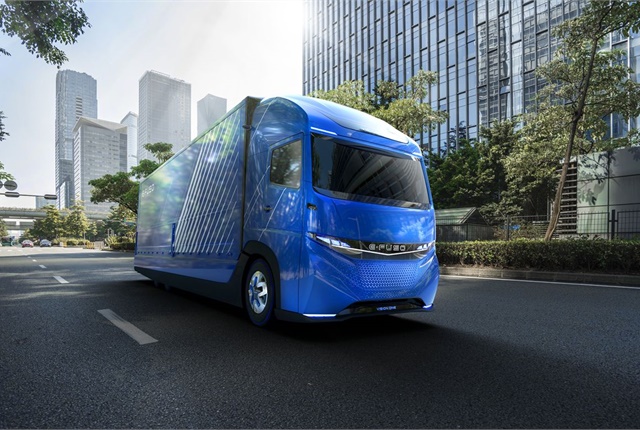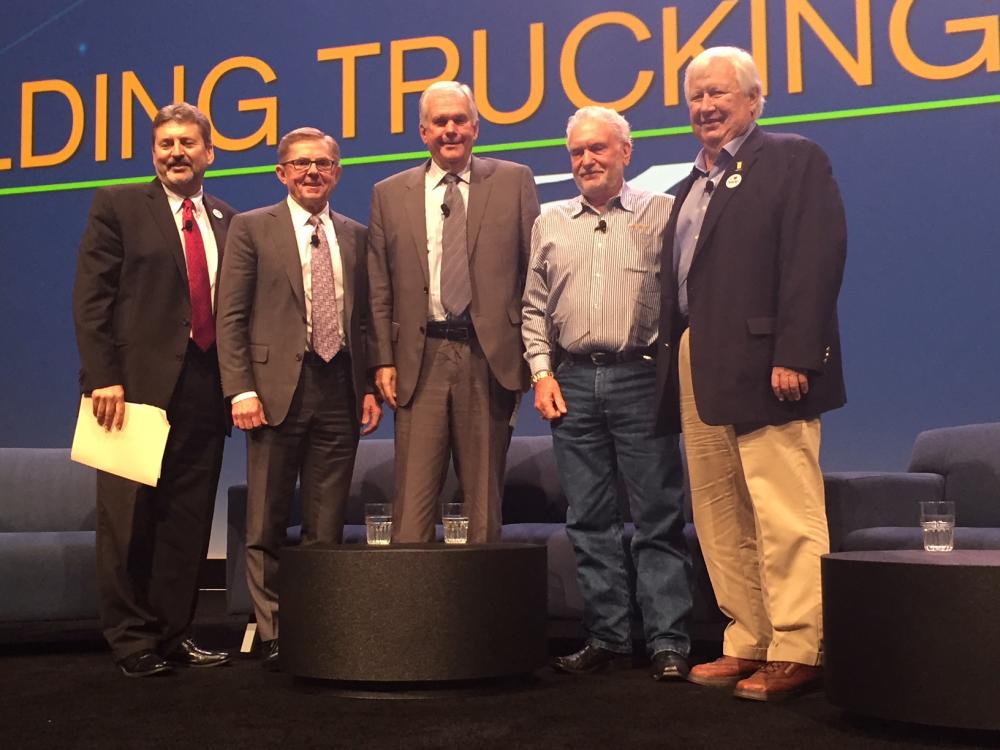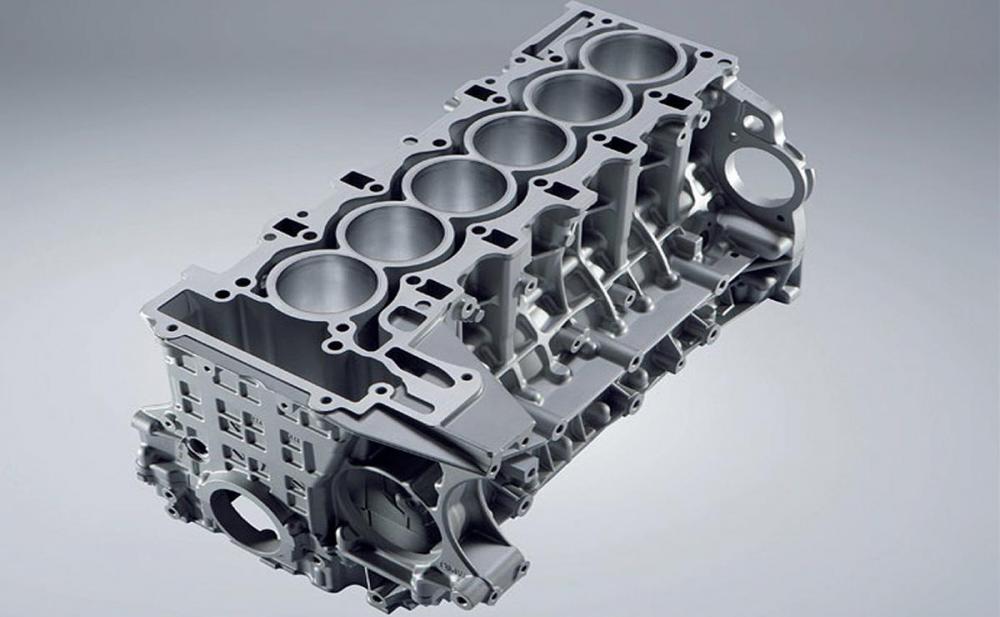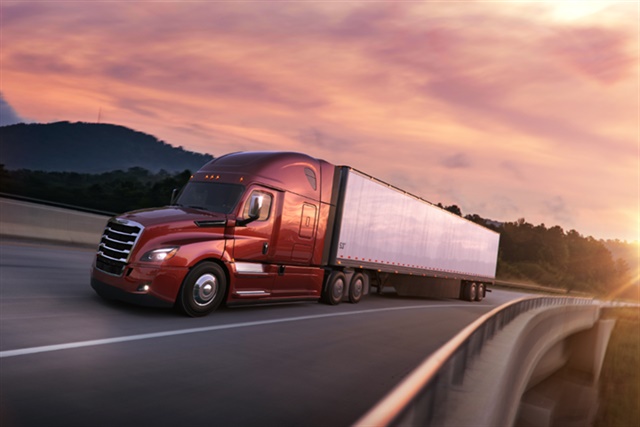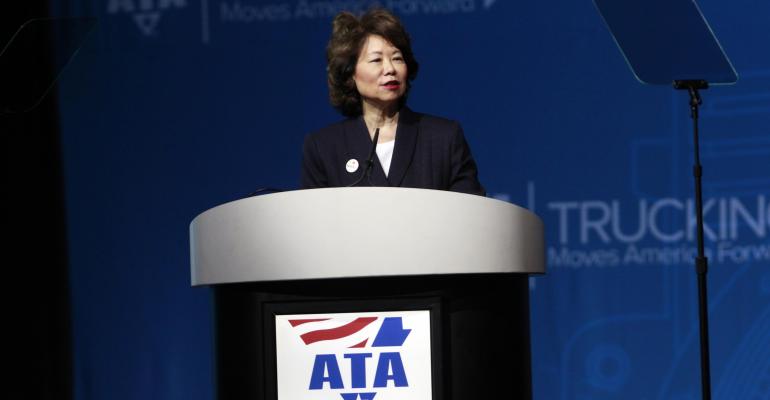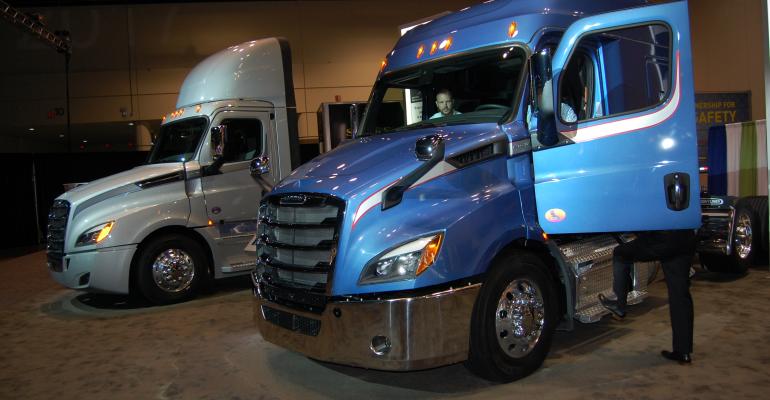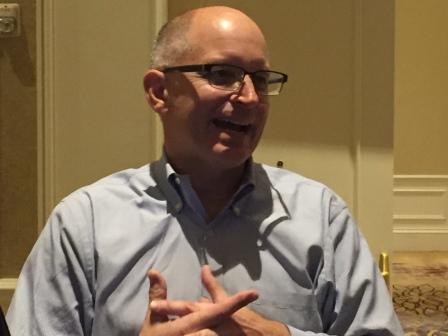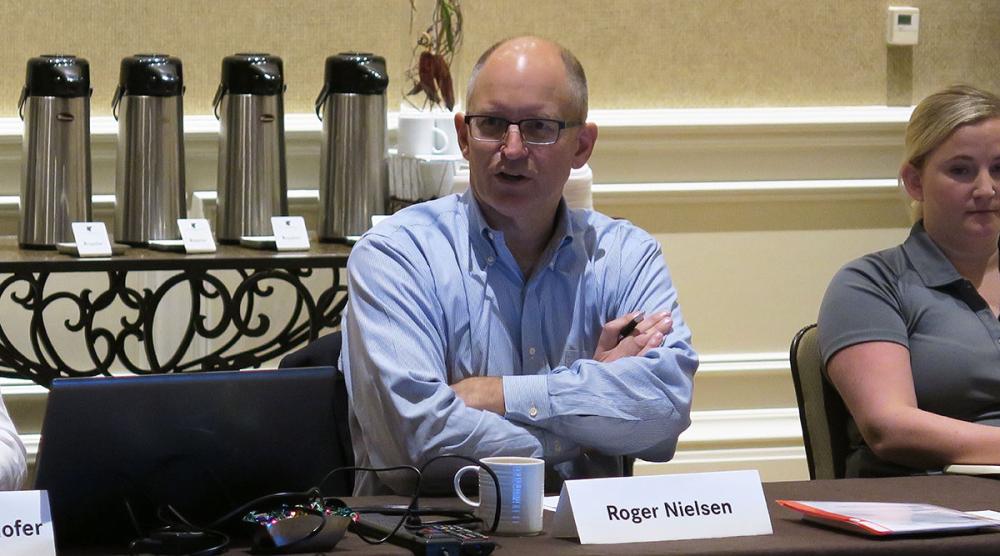
kscarbel2
Moderator-
Posts
18,855 -
Joined
-
Days Won
114
Content Type
Profiles
Forums
Gallery
Events
Blogs
BMT Wiki
Collections
Store
Everything posted by kscarbel2
-
To me, the Model 337 looks like something from 25 years ago, standing next to the modern DAF "LF" -based Model 220. COE design lends to far more efficient weight distribution and overall packaging, not to mention servicing. If USPS was my business, and I'm focused purely on functionality, performance and operating costs, the Model 220 is the winner by a landslide. Why 80% of the order is Model 337 conventionals demonstrates purchasing issues at the USPS.
-
Mack offers engine, seating, video upgrades to vocational models Fleet Owner / October 26, 2017 Mack Trucks is serving up a host of new offerings for its LR and TerraPro vocational model trucks, including new natural gas engine options and new seats, along with the prospect of eventually providing factory-installed Lytx in-cab video systems via a new “memorandum of understanding.” Announced during the 2017 Canadian Waste & Recycling Expo in Niagara Falls, Ontario, Canada, LR and TerraPro models are now available with the Cummins Westport L9N spark-ignited natural gas engine that can operate on compressed natural gas (CNG), liquefied natural gas (LNG) or renewable natural gas (RNG). Certified to the EPA’s GHG2017 emission requirements, the L9N cranks out 320 hp and 1,000 lb.-ft. of torque and produces oxides of nitrogen (NOx) exhaust emissions that are 90% lower than the current EPA limit of 0.2 g/bhp-hr, noted Curtis Dorwart, Mack’s refuse product manager, in a statement. “Natural gas continues to be a viable alternative fuel, providing a secure fuel supply and a steady price,” he explained. “With the L9N, customers can take advantage of natural gas’ benefits and further reduce their environmental footprint.” Next, Mack is now introducing a new multi-position seat for the LR model for operators in right-hand stand-up/sit down drive configuration. Developed with Sears Seating, the seat back and seat base offer adjustments that allow drivers of varying “statures” to comfortably operate the truck and joystick controls. It will be available in the first quarter of 2018, the OEM said. Finally, Mack and in-cab video provider Lytx are entering into a memorandum of understanding or “MOU,” and while details regarding the offerings under this agreement have not yet been established, the OEM is planning to incorporate the systems into its LR and TerraPro refuse models, noted David Pardue, Mack’s vice president of connected vehicles and uptime services. “Lytx DriveCam technology can help improve the safety of those on the roadway, as well as inform fleets of drivers that may need some coaching,” Pardue said. “Lytx Video Services Technology also can help with theft prevention, job site monitoring and driver safety.”
-
Heavy Duty Trucking (HDT) / October 26, 2017 Mack Trucks announced updates to its LR and TerraPro models for the waste and recycling industries, offering a natural gas engine option and more ergonomic seating, and signing a deal with Lytx to explore the DriveCam in-cab camera system. Both the Mack LR and TerraPro models are now available with the Cummins Westport L9N natural gas engine, offering near zero NOx emissions option for refuse fleets. The spark-ignited L9N is capable of running on compressed natural gas, liquefied natural gas, or renewable natural gas. It produces 320 hp and 1,000 lb.-ft. of torque. The L9N is among the lowest certified NOx emissions engines available in North America, according to Cummins Westport, producing NOx emissions that are 90% lower than the current EPA limit of 0.2 g/bhp-hr. The L9N is also certified to the EPA’s GHG2017 emission requirements. “Natural gas continues to be a viable alternative fuel, providing a secure fuel supply and a steady price,” said Curtis Dorwart, Mack refuse product manager. “With the L9N, customers can take advantage of natural gas’ benefits and further reduce their environmental footprint.” Mack also introduced a new multi-position seat for the Mack LR model, aimed at boosting comfort and ergonomics for operators in the right-hand stand-up/sit down drive configuration. The seat was developed with Sears Seating and was designed and engineered specifically for the Mack LR. “Working with Sears Seating to offer a Mack LR model-specific seat will improve the driving experience for the LR model,” said Dorwart. “The new seat is more ergonomic, more comfortable and can help improve driver productivity.” The company has also signed a memorandum of understanding with Lytx, a provider of video-based safety systems, to explore the DriveCam in-cab camera system. DriveCam records internal and external events when an abrupt lane change or hard braking occurs. The Lytx Video Services Technology can also continuously record external events regardless of a trigger situation. Details regarding the offerings under this agreement have not yet been established, but Mack is planning to incorporate the systems into its Mack LR and TerraPro refuse models.
-
Spartan receives $214 million contract from USPS Fleet Owner / October 26, 2017 Multi-year contract calls for more than 2,000 cargo body fleet vehicles. Spartan Motors Inc. announced that its Spartan Fleet Vehicles and Services (FVS) business unit — which encompasses the Utilimaster go-to-market brand — has been awarded a $214 million contract from the United States Postal Service (USPS) for more than 2,000 cargo body fleet vehicles. The contract represents the largest revenue contract in the history of Spartan Motors. “Utilimaster has been engineering and building the very best purpose-built parcel delivery vehicles for more than 40 years,” said Daryl Adams, president and CEO, Spartan Motors. “We’ve worked hard to make our products stand-out in the industry and we’re committed to manufacturing excellence.” The order from the USPS includes a combination of cab-over-engine (COE) and cab-behind-engine (CBE) Utilimaster truck bodies in a variety of 18- and 24-ft. configurations. The USPS order will be built and delivered over the span of two years, with an option for additional quantities delivered over a third contract year. Production will begin in the second quarter of 2018. “Our ability to design, custom engineer, and build commercial trucks across classes 1-6, in addition to providing custom vocation-specific upfits uniquely positions us to serve the growing ‘last mile’ delivery fleet that is in demand by today’s ecommerce retailers,” concluded Tom Ninneman, president of Spartan Fleet Vehicles and Services.
-
USPS Awards Spartan Motors $214M for Delivery Vehicles Heavy Duty Trucking (HDT) / October 26, 2017 The U.S. Postal Service has ordered 2,000 fleet vehicles from Spartan Motors on a $214 million contract for two types of delivery trucks with Utilimaster bodies, the vehicle manufacturer announced. The Charlotte, Mich.-based company's Spartan Fleet Vehicles and Services business unit will begin building the trucks after April 1. They will be delivered over the next two years. The contract includes an option for a third year. The order includes a combination of cab-over-engine and straight trucks in a variety of 18-foot and 24-foot configurations. The cabover will be built on the Class 7 Peterbilt 220 platform, while the straight truck will be a Peterbilt 337. "Our ability to design, custom engineer, and build commercial trucks across Classes 1-6, in addition to providing custom vocation-specific upfits uniquely positions us to serve the growing last mile delivery fleet that is in demand by today’s ecommerce retailers," said Tom Ninneman, president of Spartan Fleet Vehicles and Services. The USPS is also developing its next-generation residential delivery vehicle. In September of 2016, the USPS awarded $37.4 million in contracts to six vendors to provide prototypes. .
-
Ford Q3 profit jumps 63% as truck sales rise Automotive News / October 26, 2017 DETROIT -- Ford Motor Co. on Thursday said its third-quarter net income rose 63 percent to $1.6 billion, helped by foreign tax credits and strong light-truck sales in North America. Ford's revenue, pretax profit and operating margin all increased in what CFO Bob Shanks called a more balanced performance than recent quarters. Ford's adjusted pre-tax profit climbed 40 percent from a year ago to $2 billion, while revenue inched up 1 percent to $36.5 billion. Its earnings were equivalent to 39 cents per share, 6 cents better than analysts' estimates in Jim Hackett's first full quarter as the company's CEO. "This quarter demonstrates that our team's focus on fitness is showing early promise," Hackett said in a statement. "But we also know that we must accelerate that progress in the near term." Ford's profits were driven by North America, where it made a $1.7 billion pretax profit, up 31 percent from the same period in 2016. Its profit margin in the region jumped to 8.1 percent from 5.8 percent a year earlier. International results It posted lower results in Europe but performed better in the rest of the world, including record earnings in its Asia Pacific region. Ford attributed an $86 million loss in Europe, down from a $138 million profit previously, to the United Kingdom's vote to leave the European Union and costs related to launching a redesigned Fiesta sedan. It was Ford’s first quarterly loss there since the first quarter of 2015, although the company said it still expects Europe to be profitable both in the fourth quarter and for the full year. Ford lost $158 million in South America, about half as much as it did a year ago, and $60 million in its Middle East and Africa region, a $92 million improvement. Pretax profits in Asia Pacific more doubled to $289 million. Most of that growth was in areas outside of China. Ford Credit contributed $600 million in profits, a 5.8 percent increase. The automaker said it expects full-year earnings to come in between $1.75 and $1.85 per share. That is the top half of the range it had given previously. Ford, in anticipation of corporate tax-reform efforts by Congress and President Donald Trump, brought $266 million in foreign tax credits back onto its U.S. balance sheet, continuing a planning practice it started in the second quarter. Wall Street apathy Ford’s stock continues to be met largely with apathy on Wall Street. The shares rose 1.9 percent to close the day at $12.27. Hackett on Oct. 3 met with Wall Street investors promising to redirect a third of the company's internal-combustion engine expenditures to vehicle electrification and cut costs by $14 billion. CFO Bob Shanks said the results show the company is very healthy. “This is a company that has delivered value and created value over the last seven years,” Shanks told reporters at Ford’s headquarters. “We’ve delivered consistently strong results, we’ve delivered healthy margins and we’ve delivered a lot of positive cash flow and we’ve given back by the end of this year over $15 billion dollars to shareholders. As we move forward, we’re driven to create value and we’re going to strengthen and make more fit the traditional part of the biz and we have a really good plan around autonomous vehicles and EVs.” F-series sales rose 14 percent in the quarter, and Ford was able to post strong numbers despite selling fewer than 1,000 Expeditions and Lincoln Navigators in the quarter as it prepares to launch redesigned models of both high-profit SUVs. It sold more than 19,000 of the two nameplates in the same period last year. The F-series’ average transaction price rose $2,500 in the quarter to $45,400. “It’s one of those gifts that keeps on giving for us,” Hackett said. 2018 outlook Hackett and Shanks declined to offer any financial guidance on 2018, although Hackett insinuated that the company would soon give more specifics on some planned cost-cutting measures and mobility ventures. “There are a number of things…we’re working really hard to conceptualize and imagine the implications of,” he said. “There are real things coming from us about that strategy.” He said Ford would bring autonomous vehicles to a test market next year but didn’t say where or how many vehicles would be involved. Hackett, when asked if Ford might try to raise its valuation by spinning off its Smart Mobility subsidiary, which he led before being named CEO, said Ford was not ready to even consider such a move. "It's got to deliver on its promise,” he said. “We've had a lot of good things started, but it isn't at that scale yet."
-
Automotive News / October 25, 2017 TOLEDO -- Dana on Wednesday officially opened a $75 million axle plant here that will employ 350 people building up to one million axles per year for the next-generation Jeep Wrangler and the new Jeep Scrambler pickup, as well as the planned Ford Ranger and Bronco. The 300,000-square-foot axle plant was built on the same site where the former Willys-Overland produced millions of Jeeps and other vehicles, including the World War II-eraMB, the historic predecessor of the Wrangler. Dana has continuously supplied components to the Wrangler and its predecessors, the CJ and the MB, since Jeeps first started rolling off the line in Toledo in 1941. The redesigned Dana 30 and Dana 44 axles used on the next-generation Wrangler are lighter and stronger than their predecessors, Dana CEO James Kamsickas said. Production at Dana to feed FCA's upcoming JL Wrangler began Monday, Kamsickas said. Ultimately, the axle plant will feed the JL Wrangler and Jeep Scrambler pickup, built at FCA's Toledo Assembly Complex just three miles away, as well as the upcoming Ford Ranger and Bronco by 2021. .
-
- 2
-

-

-
The Last B Model
kscarbel2 replied to Rich Reinhart's topic in Antique and Classic Mack Trucks General Discussion
This includes a photo of Walter May standing in front of that truck. https://www.bigmacktrucks.com/topic/44821-mack-remembrance-–-walter-m-may/?tab=comments#comment-330342 -
The Guardian / October 26, 2017 Multiple congressional committees seek information on $300m deal awarded to Whitefish Energy Holdings, tiny company in interior secretary’s hometown Multiple congressional committees are investigating a $300m contract awarded to a small Montana company in the hometown of the interior secretary, Ryan Zinke, that was tapped to help restore Puerto Rico’s damaged power grid. The Puerto Rico Electric Power Authority awarded the contract to tiny Whitefish Energy Holdings to restore transmission and distribution lines damaged or destroyed during Hurricane Maria. The two-year-old company had just two full-time employees when the storm hit last month. In the House of Representatives, leaders of the natural resources and energy and commerce committees sent letters Thursday seeking documents about the contract, saying circumstances surrounding the award raised troubling questions. Meanwhile, the Senate energy and natural resources committee chairman, Lisa Murkowski, an Alaska Republican, vowed to hold a hearing on the issue. Two Democrats, senators Maria Cantwell of Washington state and Ron Wyden of Oregon, formally requested an investigation by the Government Accountability Office. Cantwell and Wyden questioned whether the contract cost was inflated, especially since work crews provided under mutual-aid agreements from other public utilities were available but not used. The lawmakers also complained about the “opaque and limited nature” of the bidding process conducted by the Puerto Rico authority and “contemporaneous communications” between Whitefish officials and senior members of the Trump administration, including Zinke. Cantwell is senior Democrat on the Senate energy panel, while Wyden is top Democrat on the Senate finance committee. The interior department has denied that Zinke, a former Montana congressman, played any role in the contract award. Zinke knows the Whitefish CEO, Andy Techmanski, “because they both live in a small town where everyone knows everyone”, a spokeswoman said. Zinke’s son had a summer job at a Whitefish construction site. On Wednesday, the mayor of San Juan accused the company of threatening to withdraw its services after she had demanded greater transparency about its contract. Whitefish hit back at Carmen Yulín Cruz in a tweet: “We’ve got 44 linemen rebuilding power lines in your city & 40 more men just arrived. Do you want us to send them back or keep working?” Bipartisan leaders of the House energy and commerce panel said questions raised about Whitefish’s involvement in recovery efforts make it “important to develop a clear understanding of the facts.” The committee requested a series of documents from Whitefish and asked for a briefing for committee staff by 9 November. The letter is signed by the committee chairman, Greg Walden, an Oregon Republican; the senior Democrat, Frank Pallone of New Jersey; and three other committee members. Separately, the House natural resources chairman, Rob Bishop of Utah, and the Arkansas representative Bruce Westerman, chairman of an oversight and investigations subcommittee, asked the Puerto Rican power authority for all documents related to the Whitefish contract. While speed is necessary in an emergency such as Hurricane Maria, “transparency and accountability in government contracting” must never be compromised, they wrote in a letter to Ricardo Ramos, the power authority’s executive director. Ramos said in a radio interview Thursday that Whitefish was doing an “excellent job”, adding that he has no intention of canceling the contract. “There’s been nothing illegal here,” Ramos said. Nicole Daigle, a spokeswoman for Murkowski, said the Whitefish deal “is a very large contract for a relatively new and small company, and Senator Murkowski intends to find out more about it”. Her committee expected to explore the contract at a hearing next month on hurricane recovery efforts and reconstruction of the electric grids in Puerto Rico and the US Virgin Islands, Daigle said. Senator Steve Daines, a Montana Republican, said he did not know Whitefish or its CEO, Techmanski. “The first I heard of the Whitefish Energy contract was through the news. I was surprised that such a small company from Montana got the contract,” Daines said.
-
Ford and GM went with V8 diesel designs, in the North American market, because Americans like V8s. Dodge couldn't afford to design their own and the Cummins 5.9-liter B Series was available off-the-shelf. The Cummins of course was a significantly better engine. Isuzu (6.6L Duramax) doesn't even sell a V8 in the global market (Years ago, like all the Japanese heavy truck brands, they built many V8s....Euro 1 and Euro 2). Ford told Austrian contract design firm AVL to create the current PowerStroke as a V8, feeling a V8 would sell better.
-
"The advent of the modular 500cc cylinder has brought us a flurry of 2.0-liter I-4 engines, 3.0-liter V-6 engines and 4.0-liter V-8s. A lot of this was due to cost," says AutoPacific analyst Dave Sullivan. "Being able to use the same hardware in multiple applications helps to bring costs down. The inline-six is naturally harmonically balanced, reducing the need for balancers or any expensive treatment systems," he added. ----------------------------------------------------------------------------------------------------------- Relating to that statement in the above article: Why 0.5-Liter Cylinders Will Soon Dominate Automotive-Engine Design Don Sherman, Car & Driver / January 27, 2015 A decade or so ago, a team of German university scientists settled on 500 cubic centimeters as the ideal per-cylinder displacement for internal-combustion engines. A 500-cc cylinder with a stroke length larger than its bore diameter, these forgotten pioneers concluded, benefits the combustion process by minimizing the engine’s internal surface-to-volume ratio as the piston nears top dead center. Seeking to optimize power and fuel efficiency while reducing emissions, the three local powerhouses—BMW Group, Mercedes-Benz, and Volkswagen Group—promptly joined the 500 club with boosted, direct-injected, long-stroke engines. Fiat Chrysler, Jaguar Land Rover, and Volvo are also applying for membership. Additional brands will surely follow, in part because 500-cc-displacement intervals align nicely with existing global taxation statutes. While hybrids and electrics will assist the move to better mileage with lower emissions, updated versions of Nikolaus Otto’s 139-year-old engine—many with 500-cc cylinders—will continue to do the heavy lifting. Thus far, BMW is the most enthusiastic proponent of the 500-cc cylinder, with half-liter-based three-, four-, and six-pot gas and diesel engines either in production or about to be introduced. BMW’s newest family of TwinPower Turbo gas engines, which launched in the 2015 Mini Cooper Hardtop, shares its 82-mm (3.23-inch) bore and 94.6-mm (3.72-inch) stroke dimensions, plus direct fuel injection, variable intake- and exhaust-valve timing, and variable intake-valve lift systems. This modular approach enables 60-percent commonality of the component parts across three gas engines and 30 to 40 percent with the corresponding two diesel engines. It’s not just the 500-cc displacement that matters, but also the dimensions that yield such volume. While a cylinder with a smaller bore than stroke (a so-called under-square design) contradicts the classic approach to maximum power at stratospheric rpm [see “Different Strokes”], there are compelling reasons for this move. A small bore shortens the flame travel needed to consume the fuel-air mix and diminishes quenching of the flame at the bore’s periphery. With smaller piston crowns and a more compact combustion chamber, there’s less heat lost to the cooling system. Smaller bores trade shorter overall block length for a modest increase in height, handy for jamming potent engines into tight confines. One hardship enthusiasts must bear is slightly lower redlines. In exchange, we get better mileage (when we can resist the urge to pin the throttle) and enhanced flexibility attributable to the broader spread between torque and power peaks. Considering the global statutes in place mandating higher efficiency, we’re happy that Otto’s engine has more life left in it. Different Strokes Here’s a look at two different approaches to making power. Mercedes-Benz’s 6.2-liter AMG V-8 is the last gasp of the old way, but it’s unlikely to survive until 2025. Its replacement is the twin-turbo 4.0-liter new-wave V-8 spreading throughout AMG’s lineup. Herewith, 20 boosted engines built around small-bore, long-stroke 500-cc cylinders: BMW GROUP 1.5-liter inline-three 2.0-liter inline-four 2.0-liter diesel inline-four 3.0-liter inline-six 3.0-liter diesel inline-six FIAT CHRYSLER 3.0-liter diesel V-6 JAGUAR LAND ROVER 2.0-liter diesel inline-four 3.0-liter V-6 MERCEDES-BENZ 2.0-liter inline-four 3.0-liter diesel V-6 4.0-liter V-8 VOLKSWAGEN GROUP 2.0-liter inline-four 2.0-liter diesel inline-four 3.0-liter V-6 3.0-liter diesel V-6 4.0-liter V-8 6.0-liter W-12 VOLVO 2.0-liter inline-four 2.5-liter inline-five 3.0-liter inline-six
-
Heavy Duty Trucking / October 25, 2017 Mitsubishi Fuso Truck and Bus Corporation (MFTBC) has announced it will electrify its complete range of trucks and buses in upcoming years. The company launched E-Fuso, a product brand exclusively dedicated to electric mobility of trucks and buses, and unveiled its all-electric heavy truck concept. This initiative will be backed by access to parent company Daimler’s know-how in the fields of battery and charging technology. The E-Fuso Vision One concept has a range of 200 miles. It has a gross vehicle weight of 23 tons and carries a payload of approx. 11 tons, only two tons less than its diesel counterpart. It can be fitted with batteries up to 300 kilowatt hours, enabling a range of up to 200 miles on a single charge. A potential application for the Vision One heavy-duty truck is regional intra-city distribution. Last month, the company launched its eCanter, the first serial-produced, all-electric medium-duty truck. It has a gross vehicle weight rating of 15,995 lbs. and a range of 60 to 80 miles on a single charge. While autonomous trucks are still a ways off, electric trucks are more likely to become a reality in the immediate future. Nielsen pointed out that the Mitsubishi Fuso eCanter, owned by DTNA’s parent company, is being tested by two big carriers — UPS in the U.S. and 7-11 in Japan. At the American Trucking Associations annual meeting in Orlando, FL, this week, Roger Nielsen, Daimler Trucks America president and CEO, said, "With eCanter we really have the first commercially viable electrified battery electric vehicle in the market being sold in volume," Nielsen said. "We have it out on a two-year lease. We call this eCanter version 1.0 and version 2.0 will be introduced in two years.” "Version 2.0 will be a vehicle that is designed from the ground up to be electric. You’ll see weight taken out of it and power put into it to increase the range." In Europe, Daimler has also created the Mercedes Urban eTruck, a medium truck with a range about double that of the eCanter and the type of GVWs that make sense on heavier vehicles. Trials are going on with eight customers. In the U.S. DTNA is working to electrify a Cascadia for the heavy-duty market, and “you will see it rather soon on the road,” Nielsen said. “We won’t put out a press release on it and drive it and see if you guys can catch up to us.” .
-
Hourly pay, more immigrants among ideas for solving driver shortage
kscarbel2 replied to kscarbel2's topic in Trucking News
Driver shortage overtakes ELD mandate, hours as carriers’ top concern James Jaillet, Commercial Carrier Journal (CCJ) / October 24, 2017 The availability of qualified truck drivers now ranks as the top concern for trucking companies, according to a report issued Monday by the American Transportation Research Institute, displacing the electronic logging device, which ranked No. 1 in 2016’s report, as carriers’ top issue. ATRI produces a Top 10 list of the trucking industry’s chief concerns each year. The report also includes strategies the industry can use to tackle these 10 pressing issues. This is the first time since 2006 that the driver shortage has ranked atop ATRI’s annual Critical Issues in the Trucking Industry, which is based on a survey of motor carriers and other industry personnel. More than 1,500 industry stakeholders, including carriers and drivers, responded to this year’s survey. Of the respondents, 21 percent said the driver shortage was their top concern. Another 10 percent ranked it as their second top concern, and 8 percent scored it as their third highest concern. “An optimistic trucking industry outlook, based on improving economic growth in the United States, has many in the industry concerned that the demand for truck drivers will further outpace the supply of qualified drivers,” ATRI notes in its report. Strategies to tackle the driver shortage, says ATRI, include partnering with states and the federal government to “develop a graduated CDL program to attract safe, younger drivers” and to “formalize a national truck driver recruitment program.” The ELD mandate ranked second, falling from the top spot. Eighteen percent of survey respondents said it was their chief industry issue, with 9 percent ranking it second and 6 percent ranking it third. “Given that the ELD Mandate ranked as the second-biggest issue facing the industry in 2017, it is clear that many in the industry remain concerned about the costs associated with deploying ELDs, what deployment will mean for industry productivity, and how the data collected will be used beyond [hours] compliance, while others are concerned that the implementation window will be further extended,” says ATRI’s report. Hours of service regulations took the third spot in ATRI’s Top 10 list, which ranked No. 1 in 2015’s survey. The U.S. DOT’s decision to ultimately rescind 2013-instituted regs regarding drivers’ use of a 34-hour restart eased some of the concern surrounding hours of service, ATRI says, but it remains a top industry issue “due in large part to the industry’s desire for increased flexibility in the rules,” the report notes. A chief strategy for mitigating concerns about hours of service rigidity is to continue to press for split sleeper berth flexibility, says the report. Rounding out the top 10 are: *Trucking parking, No. 4: The growing scarcity of available truck parking creates a dangerous and costly situation for truck drivers who are often forced to drive beyond allowable HOS rules or park in undesignated and, in many cases, unsafe locations,” ATRI’s report says. “The truck parking issue may gain greater attention once the ELD mandate is in effect. ATRI says the industry needs to continue to encourage state and private investment in parking facilities and to educate the public on the “safety consequences resulting from closing parking facilities.” *Driver retention, No. 5: Though related to the driver shortage, retention “remains a separate issue,” says ATRI’s report. Driver turnover has surged this year, and carriers are attempting to retain drivers with new retention programs and bonuses, the report says. *CSA, No. 6: While still a Top 10 issue, actions by Congress in recent years to scale back the program’s publicly available scores have mitigated some of the industry’s concerns. FMCSA has also undertaken a study to try to implement crash accountability into CSA. *Regulations, No. 7: “The costs associated with regulations continues as a top 10 concern for the industry,” says ATRI, despite falling from its spot in the top 5 in recent years. *Driver distraction, No. 8: ATRI says states should enact stiffer penalties and “more aggressive enforcement” of distracted driving, across all vehicle types. *Infrastructure and congestion, No. 9: “Poorly maintained roads and traffic congestion create wear and tear on vehicles, waste fuel and increase emissions, create additional stress for drivers, and negatively impact industry productivity.” ATRI says the industry needs to continue to advocate for a long-term highway funding fix at the federal level and a national freight plan that identifies freight bottlenecks and works to mitigate them. *Driver health and wellness, No. 10: “In addition to obvious lifestyle benefits, an improvement in driver health may also have positive implications for industry safety as research has identified a positive correlation between driver health and driver safety,” according to the report. ATRI says improved driver health would also help with driver retention. -
Neil Abt, Fleet Owner / October 25, 2017 Long-time trucking executives discuss ways industry is changing. ORLANDO. During this summer’s hurricanes, Grammer Industries paid about $200,000 to truck drivers in Texas, Florida, and Louisiana, even though they were not able to make their scheduled deliveries. Founder and vice chairman Shorty Whittington called the situation “damn tough” on the Indiana-based agricultural and specialized fleet, but suggested these are the lengths fleets need to go to in order to retain and recruit qualified truck drivers. “It got people to want to work for us because we treated them right,” said Whittington. He appeared at a panel discussion with three other long-time executives at the 2017 American Trucking Associations (ATA) Management Conference & Exhibition. John Smith, chairman of CRST International and the head of the ATA’s new Workforce Development Subcommittee, said creating apprentice programs and working with the federal government to allow people under the age of 21 to train to become interstate truck drivers remain critical steps toward addressing the driver shortage. Smith also said the United States must bring in more immigrants interested in becoming truck drivers because it offers higher pay than they could receive in their home countries. He added it is an unpopular idea with President Trump. Along with Dan England, chairman of C.R. England, and C.L. Werner, founder and executive chairman of Werner Enterprises, there was a consensus truck drivers need a weekly wage of at least $1,000. Whittington said one way to reach that goal is for more fleets to consider paying some drivers an hourly rate. He said he has been “tar and feathered” and told it is “business suicide” when he has raised the issue of hourly pay over the years. His response is that the turnover rates for companies that incorporate hourly pay into their business models see significantly lower. He stressed “this industry has done a terrible job communicating with shippers” about the need to assist in better compensating the drivers who are safely moving their products. As an example, he said shippers should understand the difference a driver can make, much as a waiter from a five-star restaurant is bound to offer a higher level of service than a fast-food server. Throughout the discussion, the way automation and technology is reshaping trucking was a repeated theme. Smith said the current situation reminded him of the days after deregulation of the trucking industry in 1980, when “every part of our operations changed.” England said technology will alter how fleets get the job done, “but there will always be a need for moving products across the nation’s highways.” Werner added that e-commerce will continue to alter consumer buying patterns, and that final-mile delivery services to homes would like surge in demand. “I see no end to that business,” he said. He also projected major growth in the logistics sector, offering “a lot of opportunities for small carriers.” .
-
Trump’s Economic Adviser Floats Idea of Gas Tax Hike for Infrastructure Transport Topics / October 25, 2017 President Donald Trump’s chief economic adviser raised the possibility of increasing the federal gasoline tax next year to help pay for the administration’s $1 trillion infrastructure plan, U.S. Representative Tom Reed said. National Economic Council Director Gary Cohn brought up the fuel tax as a way to help fund promised upgrades to U.S. roads, bridges and other public works during a meeting with a bipartisan group of lawmakers dubbed the Problem Solvers Caucus on Wednesday, said Reed, a New York Republican who is co-chairman of the caucus. There have been proposals over the years to raise the gas tax, which hasn’t been increased since 1993, but they have faced stiff opposition from congressional Republicans and others loath to raise taxes. As recently as May 1, after Trump floated the idea in an interview with Bloomberg News, House Ways and Means Chairman Kevin Brady seemed cold to the idea. Asked then if he’d rule it out, he said, “In my view, yes, but we’re going to have that discussion.” On Oct. 25, Brady was no more enthusiastic. “Hm. I’m going to stay focused on tax reform right now,” he said. Revenue from the federal per-gallon taxes of 18.4 cents on gasoline and 24.4 cents on diesel has declined as inflation robbed them of their purchasing power and the average fuel economy of a passenger vehicle increased by 12%, according to the U.S. Department of Transportation. Business and transportation groups have called for increasing the federal gas tax to help sustain the federal Highway Trust Fund that provides money to states for projects. Representative Mike Simpson, a Republican from Idaho, said he would support an increase. “It’s a user fee,” Simpson said. “We’ve got to convince people that the money goes to roads and bridges and not all the other bull.” In the Bloomberg News interview, Trump said he “would certainly consider” raising the U.S. gas tax to fund the infrastructure improvements he promised during the campaign. He described the idea as supported by truckers “if we earmarked money toward the highways.’’ But the White House quickly said the president wasn’t endorsing the idea. The White House didn’t immediately return a message seeking comment on Cohn’s remarks. The administration has said it plans to pursue an infrastructure package after ongoing efforts to overhaul the U.S. tax code are resolved.
-
Scania's widest bus range to date Scania Group Press Release / October 23, 2017 Scania now presents its most comprehensive range of buses and coaches with the greatest selection of alternative fuels in the market. “We can now provide operators with an outstanding freedom of choice to make the necessary shift to more sustainable passenger transport services, with retained total operating economy,” says Karin Rådström, Head of Buses and Coaches at Scania. The accelerating urban growth in the world is largely rapid suburbanisation rather than expanding city centres. That means longer commuter trips to work and, in fact, suburban public transport presently consumes three times more fuel than city centre transport. “Thus, we need a greater focus on finding non-fossil and commercially viable alternatives for these journeys,” says Karin Rådström, Head of Buses and Coaches at Scania. At Busworld in Kortrijk, Scania unveiled the latest addition to its comprehensive range of buses and coaches – the hybrid Scania Interlink Low Decker. This bus complements the versatile Scania Interlink family of low, medium and high decker buses. With the addition of hybrid technology, Scania now meets the entire scope of alternatives for suburban and inter-city operations. On certain routes with frequent stops, hybrid buses are the best choice in terms of fuel economy, carbon reduction and other emissions. Impressive carbon reductions The Scania Interlink LD is presently available for diesel, biodiesel, HVO, CNG/CBG, ethanol and, with the latest addition, hybrid. It complements the Scania Citywide Low Entry Suburban, which is also available for the full range of alternative fuels as well as a hybrid mode. The electrified bus is primarily designed for suburb-to-suburb and suburb-to-city operations in order to benefit from the full energy and economic potential of hybridisation. With the longer annual distances in these operations, hybrid buses are preferable to battery electric buses, which additionally require charging infrastructures. Operators can hereby look forward to a favourable Total Operating Economy while, in parallel, reducing their climate impact. The combined hybrid operations with the use of biodiesel or HVO can give CO2 savings of up to 90 percent. ”With the hybrid Scania Interlink LD as a further extension of our product portfolio, we now offer a fully comprehensive range for suburban operations, which constitute the greatest share of urban public transport.” says Karolina Wennerblom, Director, Product Management and Presales, Buses & Coaches. Furthermore, Scania at Busworld premiered its battery electric Scania Citywide Low Floor bus. This bus will be trialled in late 2017 to ensure that it meets the highest Scania standards before commercial release during 2018. Scania also showcased its versatile coach range at Busworld. The 12.9-metre Scania Touring coach offers an exceptional fuel consumption of less than two litres per 10 kilometres and very competitive value for money. This coach can operate on biodiesel, thereby reducing carbon emissions by more than 60 percent compared to conventional diesel. The new 12.8-metre complete Scania Interlink High Decker intercity coach was also on display at Busworld. Operating on HVO fuel, the Scania Interlink HD reaches an impressive carbon reduction of up to 90 percent. It features the widely acclaimed Scania 410 hp engine, wheelchair lift and exceptional storage space. NEW GAS TANK EXTENDS RANGE Scania is extending the operational range of its gas buses. In spite of this greater capacity, the new carbon fibre composite tanks are lighter than earlier with the potential for increasing passenger capacity. “Cities and regions around the world are increasingly taking measures to curb pollution and reduce carbon emissions. Switching to gas propulsion is an attractive alternative, reducing not only emissions but also noise,” says Karin Rådström, Head of Buses and Coaches at Scania. With the new gas tanks, Scania Citywide Low Floor and Scania Citywide Low Entry with 1,575-litre tanks will have a range of approximately 400–450 kilometres, depending on the traffic situation, topography and gas fuel quality. The top-of the-range 1,875-litre tanks will primarily benefit articulated buses, which can achieve a range of 600–700 kilometres, also depending on traffic and fuel quality. For bus chassis, Scania offers tanks with volumes 1,260, 1,575 and 1,875 litres. UPTIME GUARANTEED Scania is at the forefront of connectivity with nearly 300,000 connected vehicles. This enables Scania to extend its service Fleet Care, which enables bus operators to fully focus on providing passenger services while Scania ensures timely maintenance and repairs. This service is now being broadened with the introduction of Scania Fleet Care with Uptime Guarantee. The new service additionally focuses on maintaining uptime. Operators can select the uptime they wish to uphold in a given time frame. City bus operators might, for example, opt for 100 percent uptime Mondays through Fridays from 6 a.m. to 6 p.m. Scania will then ensure that maintenance and repairs are carried out on weekday evenings and nights as well as during weekends. “We are giving operators a wide choice in selecting the hours that really matter for them, namely those generating revenue,” says Claes Åkerlund, Head of Scania Service Concepts. “The service can be precisely tailored to their business and when their operational needs are greatest.” Scania Fleet Care with Uptime Guarantee is available for all bus bodies with Scania chassis. The Fleet Care service was first introduced in 2014 and is now actively employed around the world, for example by bus operators in Bulgaria, Chile, Norway and Spain. .
-
Richard Truett, Automotive News / October 24, 2017 Nearly 70 years since it was blown away by the high-compression Oldsmobile Rocket V8, the inline-six engine is poised to make a comeback. I'm not the first to connect these dots, but the reason for the return of the inline-six has everything to do with manufacturing efficiency and not because of an inherent fault of the V-6. As V-8s fade away, the V-6s they spawned will also diminish in numbers. BMW, which never abandoned the inline-six, has created the template for the modern modular inline engine family that other automakers are adopting. At BMW, each cylinder is 500cc and the engines are modular, meaning that they use the same basic menu of internal parts, such as valves, pistons, bearings and pumps. "The advent of the modular 500cc cylinder has brought us a flurry of 2.0-liter I-4 engines, 3.0-liter V-6 engines and 4.0-liter V-8s. A lot of this was due to cost," says AutoPacific analyst Dave Sullivan. "Being able to use the same hardware in multiple applications helps to bring costs down. The inline-six is naturally harmonically balanced, reducing the need for balancers or any expensive treatment systems," he added. When Jaguar Land Rover developed its acclaimed Ingenium gasoline and diesel engine family, it used BMW's 500cc per-cylinder and modular component strategy, but with engineering twists of its own. JLR's announcement last month that it plans to stop buying gasoline engines from Ford's Welsh engine plant in 2020, opens the door to larger Ingenium engines. JLR officials won't confirm six-cylinder Ingeniums are on the way, but it is a sure bet they are. JLR buys its V-8 and V-6 engines from Ford, and without those engines, it would have only turbo four and hybrid vehicles -- which would not develop enough torque to provide the kind of performance a Range Rover needs to take on Bentley and others. But a supercharged 3.0-liter Ingenium six could easily replace the 5.0-liter V-8. JLR's plan to halt the Ford V-6 and V-8 gasoline engine purchases in 2020 indicates the six-cylinder Ingenium engine will likely be ready for the 2021 model year -- or sooner if JLR discontinues the V-6 before the V-8. As three- and four-cylinder engines continue to deliver more power and efficiency, it's far less expensive and disruptive to add another pair of cylinders for a bigger engine with more torque than to build a V-6 that doesn't share its parts with a V-8. Mercedes' new inline-six, a 3.0-liter, comes in two flavors, Automotive News affiliate Autoweek reports, including one that cranks out 435 hp. But there are problems related to inline-sixes. Most are longer than the V-6s they will replace, making it tough to mount the engine in front-wheel-drive cars because the engine's length leaves little room for the transmission. That length also can be problematic for rear-wheel-drive cars, which may need longer hoods to accommodate the engine. And then there's safety. Engineers appear close to solving a few lingering safety problems that they didn't have to deal with when a V-6 was installed. "One of the long-standing issues [for the inline-six] has involved the length of the engine and crash standards. It appears that manufacturers are confident they can have an engine 'deform' and not penetrate the cabin," says Sullivan. But, if you've driven a BMW six lately, you know how smooth and silky an inline-six can be. Now, with direct injection, variable valve timing, electric superchargers and electrification, the inline-six just may be the configuration that propels the internal combustion engine to the finish line. .
-
James Menzies, Truck News / October 22, 2017 ORLANDO, Fla. – Navistar International sees stronger truck demand carrying into 2018, and expects to increase its share as demand increases. Michael Cancelliere, president of truck and parts for Navistar International, said at the American Trucking Associations’ Management Conference & Exhibition that the company is bullish about the economy and truck demand for the remainder of this year and into next. “Our momentum is tracking well with the momentum we’re currently experiencing as an industry,” he said during a press conference. He noted the U.S. economy is trending well, and that economic growth should strengthen during the rest of 2017 and into 2018. A side-effect of this is that commodity prices are also rising, so the cost of International trucks must go up as well. He said customers should anticipate a price increase of up to 2% on 2019 model year trucks. Cancelliere said Class 8 truck orders are poised for recovery, with freight growth showing signs of stability. Solid Classes 6/7 demand will continue, he added. This year, through August, Classes 6/7 orders are up 14.3% year-over-year, heavy-duty truck orders are up 39%, and severe service truck orders up 25.5%. He said spot market prices haven’t been this high since December 2014. “Our market share position is improving in every segment,” said Cancelliere, noting it’s up about 1.4% across all segments year-over-year. “The key enabler for this is the focus we’ve placed over the last couple years on product development.”
-
EPA to rescind glider kit emissions regs enacted last year
kscarbel2 posted a topic in Trucking News
James Jaillet, Commercial Carrier Journal (CCJ) / October 24, 2017 The Environmental Protection Agency has formally proposed to repeal the Obama-era emissions regulations placed on glider kit tractors. The glider-specific emissions regs have yet to take effect but are scheduled to begin being phased in starting next year. The emissions standards placed on glider trucks were part of the broad Phase 2 emissions rule enacted by the EPA in 2016, which calls for a 25 percent reduction in greenhouse gas emissions by tractor-trailers by 2027. EPA Administrator Scott Pruitt earlier this year announced the agency’s intentions to reevaluate the glider-specific portions of the Phase 2 standards. The agency followed through on Friday. It filed a proposal with the White House’s Office of Management and Budget to repeal the “emission requirements for glider vehicles, glider engines, and glider kits,” according to a notice posted on the OMB’s regulations portal. The rule’s glider kit restrictions would have forced glider vehicle makers to dramatically alter their operations to meet Phase 2 standards, as reported on in-depth last year by Overdrive. Glider manufacturers, such as Fitzgerald Glider Kits, have tried to engage Congress on the issue, arguing they make up such a small percentage of truck sales that they should be exempt from Phase 2 regulations. They have said the rule would “decimate” the glider kit business. Friday’s development is a win for Fitzgerald and other glider vehicle manufacturers who fought the Phase 2 emissions standards. The EPA also said it intends to evaluate the Phase 2 rule’s stipulations regarding trailer aerodynamics and emissions, following an ongoing and still unsettled lawsuit brought by the Truck and Trailer Manufacturers Association, which argues the EPA lacks statutory authority to regulate trailer emissions. -
Heavy Duty Trucking (HDT) / October 23, 2017 ORLANDO — New upgrades to Freightliner’s new Cascadia model aimed at the driver were announced at the American Trucking Associations Management Conference & Exhibition. The new updates include keyless entry and medical power supply option designed for a CPAP machine. With Keyless entry, users can lock and unlock doors, roll down windows and, if equipped, test the bulbs on the truck’s exterior before a trip. Each truck purchase includes two keyless entry transmitters that are paired at the plant and one transmitter that can be paired to multiple trucks for fleet owners. Freightliner has also added a medical power supply that’s designed to provide 8 to 10 hours of power for a typical continuous positive airway pressure device, to help drivers with breathing problems while sleeping. The optional medical device power supply includes three main components: an Absorbent Glass Mat (AGM) battery securely mounted under the bunk and vented externally; a 12-volt dedicated, labeled power outlet mounted on the front of the bunk, and a charge control isolator. The battery is automatically recharged from either the alternator or from shore power if so equipped. AGM is a fine fiberglass mat that offers the benefits of a gelled mat but can withstand more wear and tear. The battery’s design holds the electrolyte in suspension, fueling higher efficiency when discharging and recharging, according to Freightliner. “Part of what makes the new Cascadia best-in-class is that we are continually making improvements that benefit our customers,” said Kary Schaefer, general manager, marketing and strategy, Daimler Trucks North America. “Much of that focuses on safety and fuel economy of course, but we’re also making our product more productive and functional for the drivers. Each new feature is an important part of ensuring that every new Cascadia is a smart investment.” .
-
Navistar looks to bump up truck prices by 2%
kscarbel2 replied to kscarbel2's topic in Trucking News
Navistar to Raise Truck Prices by up to 2% Heavy Duty Trucking (HDT) / October 23, 2017 ORLANDO - Citing rising commodity prices, Navistar has announced that it will raise truck prices by up to 2% in the coming year. That marginal increase will be offset by the overall value that new model trucks provide to customers, said Michael Cancelliere, president trucks and parts, during a media briefing at the American Trucking Associations annual Management Conference & Exhibition. “We continually improve our own productivity, but there is a point when suppliers raise costs to us that we can’t just absorb 100% of it,” he said. “We still have to be competitive. It’s a competitive industry.” The price changes will vary by model, depending on the level of content in the different trucks. “If you can get better fuel economy on a daily basis over a three-, four-, five-year period, I’m sure that’s worth well in excess of the increase,” Cancelliere said. Every day of downtime is also valued at about $1,000 on the low side, not counting intangible costs such as dissatisfied drivers and shippers. Reliable trucks and effective service networks make a difference there. The market itself also appears to offer a growing demand for new trucks. Overall, Class 6 and 7 truck orders are up 14.3% year over year as of August, while heavy vehicle demand was up 39%, and the demand for trucks in severe service applications was up 25.5%, Cancelliere said. Navistar’s share of the medium-duty and Class 8 market has increased 1.4 points year over year, he added. Economic growth accelerated in the second and third quarter, Cancelliere said, projecting that North America’s market for Class 6, 7, and 8 vehicles will continue to rise. “Right now (with) the truckload carriers, freight is strong, capacity is tight, rates are up,” he said of the current economic environment and strong orders for sleepers. Last week, Navistar secured a $200 million order from U.S. Xpress, and he says another unnamed large fleet has placed a big order of its own. -
Chao says no infrastructure bill before tax reform Neil Abt, Fleet Owner / October 23, 2017 DOT secretary tells truckers their voices are being heard ORLANDO. No one should expect action on President Trump’s $1 trillion infrastructure proposal until after Congress completes work on tax reform. That was the message delivered by Elaine Chao, secretary of the U.S. Department of Transportation (DOT), during a speech at the 2017 American Trucking Associations Management Conference & Exhibition. Tax reform “is the focus of the Congress and the administration right now,” she said. Chao said the general plan includes $200 billion in federal funding, with the rest made up of private investment and other methods. Chao said 16 federal agencies were involved in crafting the proposal, and that she had met numerous times with trucking industry officials. “Your voices are being heard,” she told MC&E attendees. She also said DOT was continuing to look at regulatory reforms that could help speed up construction projects and create more jobs. Chao said she is working with the Federal Motor Carrier Safety Administration (FMCSA) on addressing the shortage of truck drivers. That could include further outreach to veterans, as well as to “underserved communities and women, she said. .
-
Sean Kilcarr, Fleet Owner / October 23, 2017 Company also rolls out new improvements to Cascadia model, alongside new mobile application offerings. ORLANDO. Truck production is expected to “finish strong” this year, with “no pause at all” in commercial vehicle orders, according to Roger Nielsen, president and CEO of Daimler Trucks North America (DTNA). In a round-table interview with reporters here at the 2017 American Trucking Associations (ATA) Management Conference & Exhibition (MC&E), Nielsen added that there are “no plans” at the moment to increase sticker prices on DTNA’s models, though he explained that there is “definitely pressure” as the rising costs of raw materials “is an area of discussion.” “Our plan is to remain focused on fuel efficiency and safety; that’s everything in trucking,” Nielsen said. While he didn’t provide specific numbers, he added that year-to-date (YTD) truck sales are up for DTNA versus the same point in 2016. Freightliner Business Class medium-duty model and severe-duty model sales are up 9% and 16% versus last year, while Western Star sales are up 30%. Meanwhile, sales of Freightliner Custom Chassis Corp. (FCCC) and Thomas Built Buses (TBB) among other specialty” models are up 9% as a group.Though sales of “premium” linehaul tractors are off 1% versus last year, overall, DTNA’s total YTD truck sales for the NAFTA region is up 6% versus 2016. Nielsen commented on a wide range of issues during his meeting with reporters, touching on everything from truck platooning to autonomous driving and electrification: • He views the company’s Detroit Connect Virtual Technician remote diagnostic system as “more and more of an advantage” in the trucking market in terms of reducing downtime for repairs. “It is all about uptime in this market now,” Nielsen noted. • He said everything DTNA is doing in terms of developing platooning and autonomous technology is “aimed at safety; that’s what we are putting our money on – everything we can do to make the driver’s life safer and help them complete their mission,” in part because “we don’t believe trucks will be completely driverless in the future.” • In terms of truck platooning research “there is technically no limit” as to how many tractor-trailers one can “synch together.” However, “we are still searching or applications that make sense for two-truck platoons; we’ve not seen anyone yet asking for five-truck platooning applications.” • Nielsen noted that DTNA now refers to itself as “a mobile device company that happens to build trucks and buses” because today’s trucks and buses are becoming like iPhones; the technological “base” for different applications. • “It doesn’t make sense for a customer to have 18 different [communication] contracts for cameras, braking systems, telematics, and other technologies,” he explained. “Our capacity, our ‘box,’ can provide a single electronics and communication platform. Apple for example does not write every software application for its iPhone; it acts as a host for them.” • While DTNA is watching fuel economy and greenhouse gas (GHG) regulation rollback discussions closely, “regardless of what happens, we’ve moved on with our business plans,” Nielsen said. • A major concern with autonomous vehicle technology is the “shifting of liability” when it comes to crashes and managing traffic congestion, he said; issues still being debated. • Are electric trucks viable? Nielsen noted that DTNA plans a “full launch” of the eCanter all-electric medium-duty truck built by its Mitsubishi Fuso division in Japan, the U.S., and European Union nations in 2019 with four models, followed by “more models in multiple classes” in 2020 and beyond. • “We believe we still need more power density from the batteries and lower total cost of operation (TCO),” he said. “We’re working with fleets right now to define different use cases.” DTNA also made several product announcements during the annual ATA MC&E. First the company is offering a series of upgrades to the Freightliner Cascadia family of heavy-trucks, including: • Keyless entry that that not only offers buttons for locking and unlocking the doors but that also rolls down windows and tests the bulbs on the truck’s exterior lights prior to driving the vehicle. Each truck purchase includes two keyless entry transmitters that are paired at the plant, with one transmitter capable of being paired to multiple trucks. • A new built-in power supply for medical devices, powered by an absorbent glass mat (AGM) battery mounted under the bunk and vented externally that offers eight to 10 hours of power for equipment such as a Continuous Positive Airway Pressure (CPAP) device for drivers with sleep apnea. DTNA is also making its new Detroit Connect mobile application available for download for Freightliner and Western Star customers who have an active Detroit Connect subscription, which allows them to access information about their vehicles’ performance without needing to be at a desk or on a computer. The new app, available for iOS or Android-enabled mobile devices, is available for free in Apple’s App Store or Google Play, DTNA said, with access to the new Detroit Connect portal and mobile app included with any active Detroit Connect subscription at no charge. Finally, the OEM noted that its Detroit Connect Virtual Technician remote diagnostic system can now deliver remote fault event diagnostics for Detroit DT12 automated manual transmissions (AMT) – monitoring up to 150 distinct faults for that gearbox. The Virtual Technician diagnostic process for the DT12 is similar to the process for Detroit engine and after-treatment systems, DTNA said, with fault events “categorized” based on how severe vehicle drivability is affected. “Since we launched Virtual Technician in 2011, we have been improving it by integrating additional Detroit components,” said Kary Schaefer, general manager, marketing and strategy, Daimler Trucks North America. “We pride ourselves on helping customers understand their truck’s health and maximizing the uptime.” .
-
Transport Topics / October 24, 2017 ORLANDO, Fla. — Daimler Trucks North America continues its pursuit of automated driving technology, but that development path is focused not on “autonomous” trucks but advanced driver-assistance systems, CEO Roger Nielsen said. “You’ll see us change our language to advanced driver-assistance systems, or active safety. You won’t see us talking about autonomous,” Nielsen said during an Oct. 24 roundtable discussion with industry press here during American Trucking Associations’ Management Conference & Exhibition. DTNA, which builds Freightliner and Western Star trucks and Detroit engines and components, remains firm in its belief that trucks will not become driverless in the foreseeable future. “The driver does more than just steer, brake and accelerate,” Nielsen said, adding that professional drivers provide customer service, perform pre-and post-trip vehicle inspections and respond to unexpected issues that arise on the road. DTNA helped ignite conversations about trucking’s future when it unveiled its self-driving Freightliner Inspiration concept truck at the Hoover Dam in 2015, but the company has since moderated its tone on autonomous driving technology. Nielsen compared the development of automated trucks to space exploration. The real benefit isn’t just landing on the moon; it’s everything that was invented on the way. Similarly, the pathway toward higher levels of automation will yield further advancements in active safety, which “helps us get to the point of accident free driving,” Nielsen said. “And that’s the key here. We want drivers to come home safe and less tired.” One new form of ADAS technology that DTNA is currently testing is truck platooning, which combines active safety systems with vehicle-to-vehicle communication to enable a pair of trucks to travel down the highway in a tight, aerodynamic formation. Nielsen reiterated DTNA’s stance that active lane keeping for the following truck will be “absolutely required to make platooning work.” That active steering capability will help the driver of the second truck, who will have limited visibility as the vehicle travels about 45 feet behind the lead truck at highway speeds. “We are not ready to announce a market availability of platooning yet, although you’ll see us come out soon with active lane keeping as yet another advanced driver-assistance system,” Nielsen said. Daimler also continues to explore electric-powered trucks. The company recently introduced its fully electric Fuso eCanter medium-duty cabover in the United States, Japan and Europe with a full launch aimed for 2019. In Europe, Daimler also is planning tests and trials for its heavy-duty Mercedes-Benz Urban e-Truck ahead of a broader launch in 2020 or beyond. In the United States, DTNA has plans in place to electrify the Freightliner Cascadia, Nielsen said. However, he acknowledged that the industry still “has a lot to learn” about increasing power density, reducing weight and providing a viable total cost of ownership with electric trucks. “Our focus at the moment is not on the business case,” he said. “Our focus right now is on bringing the technology to a higher level.” Nielsen also provided a brief overview of this year’s truck market. Year-to-date through September, DTNA reported a 10% decline in the U.S. Class 8 market, but a 0.3% uptick in market share compared with the previous year. The U.S. Classes 6 and 7 market edged up 1%, and DTNA’s share of that market rose 0.7%, the company said. .
BigMackTrucks.com
BigMackTrucks.com is a support forum for antique, classic and modern Mack Trucks! The forum is owned and maintained by Watt's Truck Center, Inc. an independent, full service Mack dealer. The forums are not affiliated with Mack Trucks, Inc.
Our Vendors and Advertisers
Thank you for your support!


